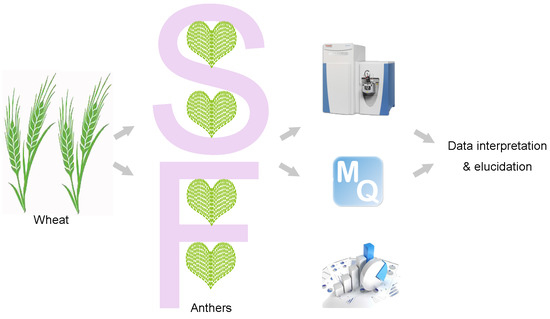Comparative Proteomic Analysis of Developmental Changes in P-Type Cytoplasmic Male Sterile and Maintainer Anthers in Wheat
Abstract
1. Introduction
2. Results
2.1. Observation of Defects during Anther Development in the CMS Line
2.2. Cytological Analysis of Microspore Development
2.3. Proteomic Analysis of Anthers at Different Stages
2.4. Analysis of DEPs during Anther Development
2.5. Subcellular Localization Prediction and Domain Enrichment Analysis of DEPs
2.6. GO Functional Classification and Enrichment Analysis of DEPs in Anthers
2.7. KEGG Pathway Enrichment and Cluster Analysis
2.8. PPI Networks and Metabolic Pathway Analysis
2.9. Expression Analysis of Genes and Their Cognate DEPs
3. Discussion
3.1. The Pollen Abortion Type of P-Type CMS Line Belongs to Binucleate Microspore Abortion
3.2. Early Tapetum Degradation and Anther Cuticle Defects Are Associated with Male Sterility
3.3. Starch and Sucrose Metabolism Is a Major Factor Causing Male Sterility in P-Type Wheat
3.4. Carbohydrate and Energy Metabolism
4. Materials and Methods
4.1. Plant Material and Anther Collection
4.2. Phenotypic Characterization and Microspore Analysis of Anthers
4.3. Histological Analysis
4.4. Protein Extraction and Digestion
4.5. Identification of Peptides
4.6. Bioinformatics Analysis
4.7. Quantitative Real-Time PCR (qRT-PCR) Assay
5. Conclusions
Supplementary Materials
Author Contributions
Funding
Institutional Review Board Statement
Informed Consent Statement
Data Availability Statement
Conflicts of Interest
References
- Kaul, M.L.H. Male Sterility in Higher Plants; Springer: Heidelberg, Germany, 1988; Volume 10. [Google Scholar]
- Liu, H.T.; Cui, P.; Zhan, K.H.; Lin, Q.; Zhuo, G.Y.; Guo, X.L.; Ding, F.; Yang, W.L.; Liu, D.C.; Hu, S.N.; et al. Comparative analysis of mitochondrial genomes between a wheat K-type cytoplasmic male sterility (CMS) line and its maintainer line. BMC Genom. 2011, 12, 163. [Google Scholar] [CrossRef]
- Wan, C.X.; Li, S.P.; Wen, L.; Kong, J.; Wang, K.; Zhu, Y.G. Damage of oxidative stress on mitochondria during microspores development in Honglian CMS line of rice. Plant. Cell Rep. 2007, 26, 373–382. [Google Scholar] [CrossRef]
- Mackenzie, S.; He, S.; Lyznik, A. The elusive plant mitochondrion as a genetic system. Plant Physiol. 1994, 105, 775–780. [Google Scholar] [CrossRef] [PubMed]
- Schnable, P.S.; Wise, R.P. The molecular basis of cytoplasmic male sterility. Trends Plant. Sci. 1998, 3, 175–180. [Google Scholar] [CrossRef]
- Gong, W.P.; Li, G.R.; Zhou, J.P.; Li, G.Y.; Liu, C.; Huang, C.Y.; Zhao, Z.D.; Yang, Z.J. Cytogenetic and molecular markers for detecting Aegilops uniaristata chromosomes in a wheat background. Genome 2014, 57, 489–497. [Google Scholar] [CrossRef]
- Feldman, M.; Levy, A.A. Allopolyploidy—A shaping force in the evolution of wheat genomes. Cytogenet. Genome Res. 2005, 109, 250–258. [Google Scholar] [CrossRef]
- Kihara, H. Discovery of the DD-analyser, one of the ancestors of Triticum vulgare. Agric. Hortic. 1944, 19, 13–14. [Google Scholar]
- McCormick, S. Control of male gametophyte development. Plant. Cell 2004, 16, S142–S153. [Google Scholar] [CrossRef]
- Liu, J.J.; Qu, L.J. Meiotic and mitotic cell cycle mutants involved in gametophyte development in Arabidopsis. Mol. Plant 2008, 1, 564–574. [Google Scholar] [CrossRef] [PubMed]
- Scott, R.; Hodge, R.; Paul, W.; Draper, J. The molecular biology of anther differentiation. Plant Sci. 1991, 80, 167–191. [Google Scholar] [CrossRef]
- Zhang, J.K.; Zong, X.F.; Yu, G.D.; Li, J.N.; Zhang, W. Relationship Between Phytohormones and Male Sterility in Thermo-Photo-Sensitive Genic Male Sterile (TGMS) Wheat. Euphytica 2006, 150, 241–248. [Google Scholar] [CrossRef]
- Wang, S.P.; Zhang, Y.X.; Song, Q.L.; Fang, Z.W.; Chen, Z.; Zhang, Y.M.; Zhang, L.L.; Zhang, L.; Niu, N.; Ma, S.C.; et al. Mitochondrial Dysfunction Causes Oxidative Stress and Tapetal Apoptosis in Chemical Hybridization Reagent-Induced Male Sterility in Wheat. Front. Plant Sci. 2017, 8, 2217. [Google Scholar] [CrossRef] [PubMed]
- Sheoran, I.S.; Sproule, K.A.; Olson, D.J.H.; Ross, A.R.S.; Sawhney, V.K. Proteome profile and functional classification of proteins in Arabidopsis thaliana (Landsberg erecta) mature pollen. Sex. Plant Reprod. 2006, 19, 185–196. [Google Scholar] [CrossRef]
- Kerim, T.; Imin, N.; Weinman, J.J.; Rolfe, B.G. Proteome analysis of male gametophyte development in rice anthers. Proteomics 2003, 3, 738–751. [Google Scholar] [CrossRef] [PubMed]
- Sun, Q.P.; Hu, C.F.; Hu, J.; Li, S.Q.; Zhu, Y.G. Quantitative proteomic analysis of CMS-related changes in Honglian CMS rice anther. Protein J. 2009, 28, 341–348. [Google Scholar] [CrossRef]
- Sheoran, I.S.; Ross, A.R.S.; Olson, D.J.H.; Sawhney, V.K. Proteomic analysis of tomato (Lycopersicon esculentum) pollen. J. Exp. Bot. 2007, 58, 3525–3535. [Google Scholar] [CrossRef]
- McNeil, K.J.; Smith, A.G. An anther-specific cysteine-rich protein of tomato localized to the tapetum and microspores. J. Plant Physiol. 2005, 162, 457–464. [Google Scholar] [CrossRef]
- Wu, S.; O’Leary, S.J.; Gleddie, S.; Eudes, F.; Laroche, A.; Robert, L.S. A chalcone synthase-like gene is highly expressed in the tapetum of both wheat (Triticum aestivum L.) and triticale (xTriticosecale Wittmack). Plant Cell Rep. 2008, 27, 1441–1449. [Google Scholar] [CrossRef]
- Wang, S.P.; Zhang, G.S.; Song, Q.L.; Zhang, Y.X.; Li, Z.; Guo, J.L.; Niu, N.; Ma, S.C.; Wang, J.W. Abnormal development of tapetum and microspores induced by chemical hybridization agent SQ-1 in wheat. PLoS ONE 2015, 10, e0119557. [Google Scholar] [CrossRef]
- Wan, L.L.; Zha, W.J.; Cheng, X.Y.; Liu, C.; Lv, L.; Liu, C.X.; Wang, Z.Q.; Du, B.; Chen, R.Z.; Zhu, L.L.; et al. A rice beta-1,3-glucanase gene Osg1 is required for callose degradation in pollen development. Planta 2011, 233, 309–323. [Google Scholar] [CrossRef] [PubMed]
- Holmes-Davis, R.; Tanaka, C.K.; Vensel, W.H.; Hurkman, W.J.; McCormick, S. Proteome mapping of mature pollen of Arabidopsis thaliana. Proteomics 2005, 5, 4864–4884. [Google Scholar] [CrossRef] [PubMed]
- Sheoran, I.S.; Ross, A.R.; Olson, D.J.; Sawhney, V.K. Differential expression of proteins in the wild type and 7B-1 male-sterile mutant anthers of tomato (Solanum lycopersicum): A proteomic analysis. J. Proteom. 2009, 71, 624–636. [Google Scholar] [CrossRef] [PubMed]
- Sheoran, I.S.; Sawhney, V.K. Proteome analysis of the normal and Ogura(ogu) CMS anthers of Brassica napusto identify proteins associated with male sterility. Botany 2010, 88, 217–230. [Google Scholar] [CrossRef]
- Xue, H.; Lü, B.; Zhang, J.; Wu, M.; Huang, Q.; Wu, Q.; Sheng, H.; Wu, D.; Hu, J.; Lai, M. Identification of serum biomarkers for colorectal cancer metastasis using a differential secretome approach. J. Proteome Res. 2010, 9, 545–555. [Google Scholar] [CrossRef]
- Mora, L.; Bramley, P.M.; Fraser, P.D. Development and optimisation of a label-free quantitative proteomic procedure and its application in the assessment of genetically modified tomato fruit. Proteomics 2013, 13, 2016–2030. [Google Scholar] [CrossRef]
- Neilson, K.A.; Ali, N.A.; Muralidharan, S.; Mirzaei, M.; Mariani, M.; Assadourian, G.; Lee, A.; van Sluyter, S.C.; Haynes, P.A. Less label, more free: Approaches in label-free quantitative mass spectrometry. Proteomics 2011, 11, 535–553. [Google Scholar] [CrossRef]
- Ye, Y.; Zhang, Z.B.; Long, H.F.; Zhang, Z.M.; Hong, Y.; Zhang, X.M.; You, C.J.; Liang, W.Q.; Ma, H.; Lu, P.L. Proteomic and phosphoproteomic analyses reveal extensive phosphorylation of regulatory proteins in developing rice anthers. Plant. J. 2015, 84, 527–544. [Google Scholar] [CrossRef] [PubMed]
- Laser, K.D.; Lersten, N.R. Anatomy and cytology of microsporogenesis in cytoplasmic male sterile angiosperms. Bot. Rev. 1972, 38, 425–454. [Google Scholar] [CrossRef]
- Wang, S.P.; Zhang, Y.X.; Fang, Z.W.; Zhang, Y.M.; Song, Q.L.; Hou, Z.H.; Sun, K.K.; Song, Y.L.; Li, Y.; Ma, D.F.; et al. Cytological and Proteomic Analysis of Wheat Pollen Abortion Induced by Chemical Hybridization Agent. Int. J. Mol. Sci. 2019, 20, 1615. [Google Scholar] [CrossRef]
- Li, L.; Li, Y.X.; Song, S.F.; Deng, H.F.; Li, N.; Fu, X.Q.; Chen, G.H.; Yuan, L.P. An anther development F-box (ADF) protein regulated by tapetum degeneration retardation (TDR) controls rice anther development. Planta 2015, 241, 157–166. [Google Scholar] [CrossRef]
- Liu, Z.H.; Shi, X.Y.; Li, S.; Hu, G.; Zhang, L.L.; Song, X.Y. Tapetal-Delayed Programmed Cell Death (PCD) and Oxidative Stress-Induced Male Sterility of Aegilops uniaristata Cytoplasm in Wheat. Int. J. Mol. Sci. 2018, 19, 1708. [Google Scholar] [CrossRef]
- Liu, J.; Pang, C.Y.; Wei, H.L.; Song, M.Z.; Meng, Y.Y.; Fan, S.L.; Yu, S.X. Proteomic analysis of anthers from wild-type and photosensitive genetic male sterile mutant cotton (Gossypium hirsutum L.). BMC Plant Biol. 2014, 14, 390. [Google Scholar] [CrossRef]
- Li, H.; Zhang, D.B. Biosynthesis of anther cuticle and pollen exine in rice. Plant. Signal. Behav. 2010, 5, 1121–1123. [Google Scholar] [CrossRef]
- Chang, Z.Y.; Chen, Z.F.; Yan, W.; Xie, G.; Lu, J.W.; Wang, N.; Lu, Q.Q.; Yao, N.; Yang, G.Z.; Xia, J.X.; et al. An ABC transporter, OsABCG26, is required for anther cuticle and pollen exine formation and pollen-pistil interactions in rice. Plant. Sci. Int. J. Exp. Plant Biol. 2016, 253, 21–30. [Google Scholar] [CrossRef]
- Liu, Z.; Lin, S.; Shi, J.X.; Yu, J.; Zhu, L.; Yang, X.J.; Zhang, D.B.; Liang, W. Rice No Pollen 1 (NP1) is required for anther cuticle formation and pollen exine patterning. Plant. J. Cell Mol. Biol. 2017, 91, 263–277. [Google Scholar] [CrossRef] [PubMed]
- Graça, J.; Lamosa, P. Linear and branched poly(omega-hydroxyacid) esters in plant cutins. J. Agric. Food Chem. 2010, 58, 9666–9674. [Google Scholar] [CrossRef] [PubMed]
- Schreiber, L. Transport barriers made of cutin, suberin and associated waxes. Trends Plant. Ence 2010, 15, 546–553. [Google Scholar] [CrossRef]
- Zhu, L.; Shi, J.X.; Zhao, G.C.; Zhang, D.B.; Liang, W.Q. Post-meiotic deficient anther1 (PDA1) encodes an ABC transporter required for the development of anther cuticle and pollen exine in rice. J. Plant. Biol. 2013, 56, 59–68. [Google Scholar] [CrossRef]
- Yang, X.J.; Liang, W.Q.; Chen, M.J.; Zhang, D.B.; Zhao, X.X.; Shi, J.X. Rice fatty acyl-CoA synthetase OsACOS12 is required for tapetum programmed cell death and male fertility. Planta 2017, 246, 105–122. [Google Scholar] [CrossRef] [PubMed]
- Sang-Kyu, L.; Joon-Seob, E.; Seon-Kap, H.; Dongjin, S.; Gynheung, A.; Okita, T.W.; Jong-Seong, J. Plastidic phosphoglucomutase and ADP-glucose pyrophosphorylase mutants impair starch synthesis in rice pollen grains and cause male sterility. J. Exp. Bot. 2016, 67, 5557–5569. [Google Scholar]
- Vizcay-Barrena, G. Altered tapetal PCD and pollen wall development in the Arabidopsis ms1 mutant. J. Exp. Bot. 2006, 57, 2709. [Google Scholar] [CrossRef] [PubMed]
- Zhang, G.M.; Ye, J.L.; Jia, Y.L.; Zhang, L.L.; Song, X.Y. iTRAQ-Based Proteomics Analyses of Sterile/Fertile Anthers from a Thermo-Sensitive Cytoplasmic Male-Sterile Wheat with Aegilops kotschyi Cytoplasm. Int. J. Mol. Sci. 2018, 19, 1344. [Google Scholar] [CrossRef] [PubMed]
- Clement, C.; Burrus, M.; Audran, J.C. Floral organ growth and carbohydrate content during pollen. Am. J. Bot. 1996, 83, 459–469. [Google Scholar] [CrossRef]
- Wu, Z.M.; Cheng, J.W.; Qin, C.; Hu, Z.Q.; Yin, C.X.; Hu, K.L. Differential Proteomic Analysis of Anthers between Cytoplasmic Male Sterile and Maintainer Lines in Capsicum annuum L. Int. J. Mol. Sci. 2013, 14, 22982–22996. [Google Scholar] [CrossRef] [PubMed]
- Mamun, E.A.; Alfred, S.; Cantrill, L.C.; Overall, R.L.; Sutton, B.G. Effects of chilling on male gametophyte development in rice. Cell Biol. Int. 2006, 30, 583–591. [Google Scholar] [CrossRef]
- Guo, J.J.; Wang, P.; Cheng, Q.; Sun, L.M.; Wang, H.Y.; Wang, Y.T.; Kao, L.N.; Li, Y.N.; Qiu, T.Y.; Yang, W.C.; et al. Proteomic analysis reveals strong mitochondrial involvement in cytoplasmic male sterility of pepper (Capsicum annuum L.). J. Proteom. 2017, 168, 15–27. [Google Scholar] [CrossRef] [PubMed]
- Yui, R.; Iketani, S.; Mikami, T.; Kubo, T. Antisense inhibition of mitochondrial pyruvate dehydrogenase E1alpha subunit in anther tapetum causes male sterility. Plant. J. 2010, 34, 57–66. [Google Scholar] [CrossRef]
- Salvato, F.; Havelund, J.F.; Chen, M.; Rao, R.S.P.; Rogowska-Wrzesinska, A.; Jensen, O.N.; Gang, D.R.; Thelen, J.J.; Møller, I.M. The Potato Tuber Mitochondrial Proteome. Plant Physiol. 2014, 164, 637–653. [Google Scholar] [CrossRef]
- Logan, D.C. The mitochondrial compartment. J. Exp. Bot. 2006, 57, 1225–1243. [Google Scholar] [CrossRef]
- Wang, S.P.; Zhang, G.S.; Zhang, Y.X.; Song, Q.L.; Chen, Z.; Wang, J.; Guo, J.L.; Niu, N.; Wang, J.W.; Ma, S.C. Comparative studies of mitochondrial proteomics reveal an intimate protein network of male sterility in wheat (Triticum aestivum L.). J. Exp. Bot 2015, 66, 6191–6203. [Google Scholar] [CrossRef]
- Zheng, S.Y.; Li, J.; Ma, L.; Wang, H.L.; Zhou, H.; Ni, E.; Jiang, D.G.; Liu, Z.L.; Zhuang, C.X. OsAGO2 controls ROS production and the initiation of tapetal PCD by epigenetically regulating OsHXK1 expression in rice anthers. Proc. Natl. Acad. Sci. USA 2019, 116, 7549–7558. [Google Scholar] [CrossRef]
- Yi, J.; Moon, S.; Lee, Y.S.; Zhu, L.; Liang, W.Q.; Zhang, D.B.; Jung, K.H.; An, G. Defective Tapetum Cell Death 1 (DTC1) Regulates ROS Levels by Binding to Metallothionein during Tapetum Degeneration. Plant. Physiol. 2016, 170, 1611–1623. [Google Scholar] [CrossRef] [PubMed]
- Ba, Q.S.; Zhang, G.S.; Wang, J.S.; Che, H.X.; Liu, H.Z.; Niu, N.; Ma, S.C.; Wang, J.W. Relationship between metabolism of reactive oxygen species and chemically induced male sterility in wheat (Triticum aestivum L.). Can. J. Plant Sci. 2013, 93, 675–681. [Google Scholar] [CrossRef]
- Zhang, L.Y.; Zhang, G.S.; Zhao, X.L.; Yang, S.L. Screening and Analysis of Proteins Interacting with TaPDK from Physiological Male Sterility Induced by CHA in Wheat. J. Integr. Agric. 2013, 12, 941–950. [Google Scholar] [CrossRef]
- Zhang, D.D.; Liu, D.; Lv, X.M.; Wang, Y.; Xun, Z.L.; Liu, Z.X.; Li, F.L.; Lu, H. The Cysteine Protease CEP1, a Key Executor Involved in Tapetal Programmed Cell Death, Regulates Pollen Development in Arabidopsis. Plant. Cell 2014, 26, 2939–2961. [Google Scholar] [CrossRef] [PubMed]
- Zhang, J.; Wu, L.S.; Fan, W.; Zhang, X.L.; Jia, H.X.; Li, Y.; Yin, Y.F.; Hu, J.J.; Lu, M.Z. Proteomic analysis and candidate allergenic proteins in Populus deltoides CL. “2KEN8” mature pollen. Front. Plant Sci. 2015, 6, 548. [Google Scholar] [CrossRef]
- Wisniewski, J.R.; Zougman, A.; Nagaraj, N.; Mann, M. Universal sample preparation method for proteome analysis. Nat. Methods 2009, 6, 359–362. [Google Scholar] [CrossRef]
- Cox, J.; Mann, M. MaxQuant enables high peptide identification rates, individualized p.p.b.-range mass accuracies and proteome-wide protein quantification. Nat. Biotechnol. 2008, 26, 1367–1372. [Google Scholar] [CrossRef] [PubMed]
- Geiger, T.; Wehner, A.; Schaab, C.; Cox, J.; Mann, M. Comparative proteomic analysis of eleven common cell lines reveals ubiquitous but varying expression of most proteins. Mol. Cell. Proteom. Mcp 2012, 11, 014050. [Google Scholar] [CrossRef] [PubMed]
- Schwanhausser, B.; Busse, D.; Li, N.; Dittmar, G.; Schuchhardt, J.; Wolf, J.; Chen, W.; Selbach, M. Global quantification of mammalian gene expression control. Nature 2011, 473, 337–342. [Google Scholar] [CrossRef]
- Efron, B. Size, power and false discovery rates. Ann. Stat. 2007, 35, 1351–1377. [Google Scholar] [CrossRef]

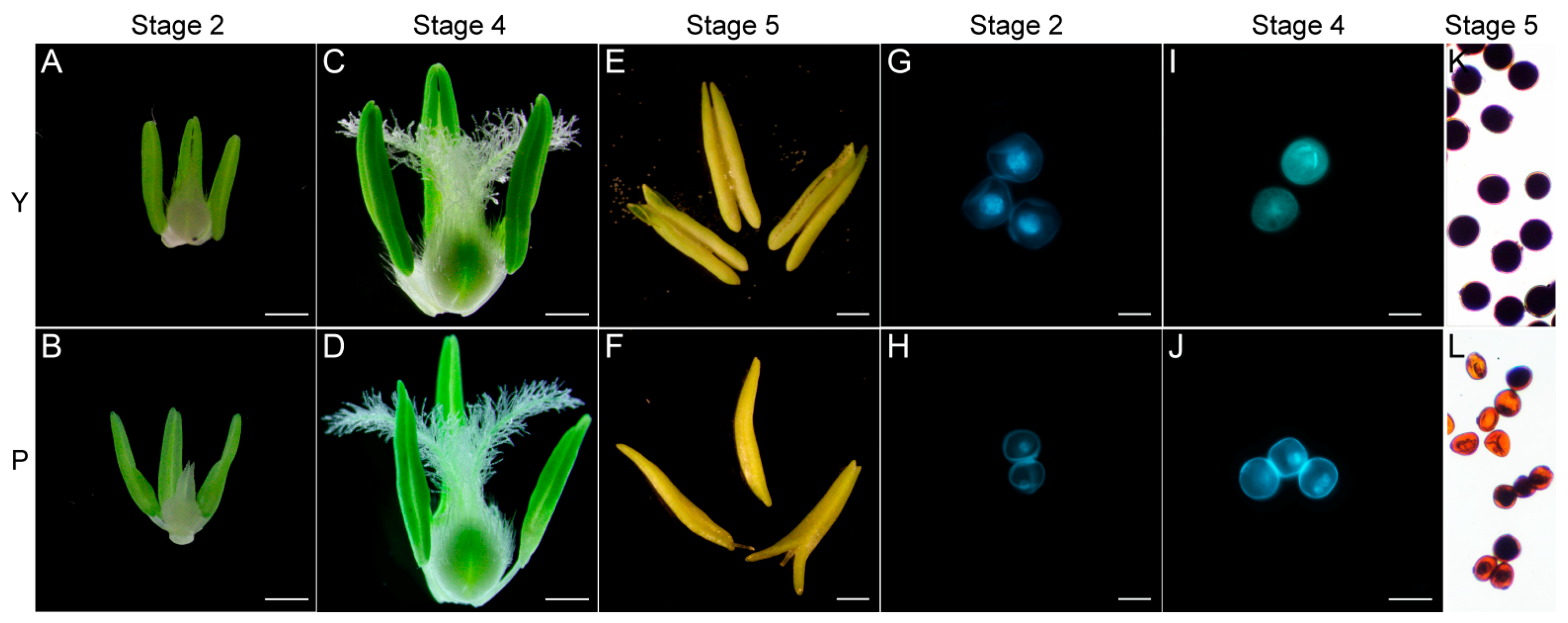
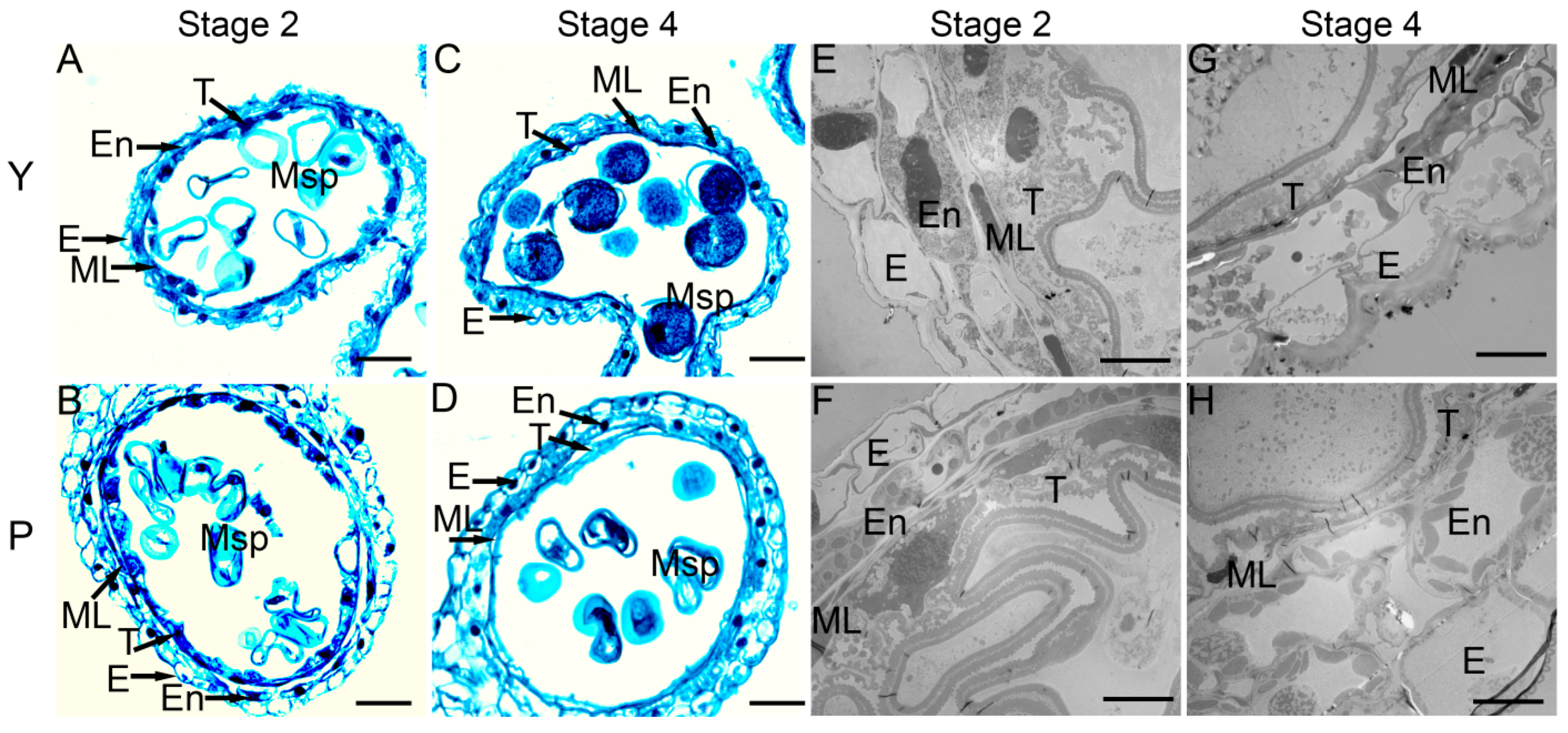
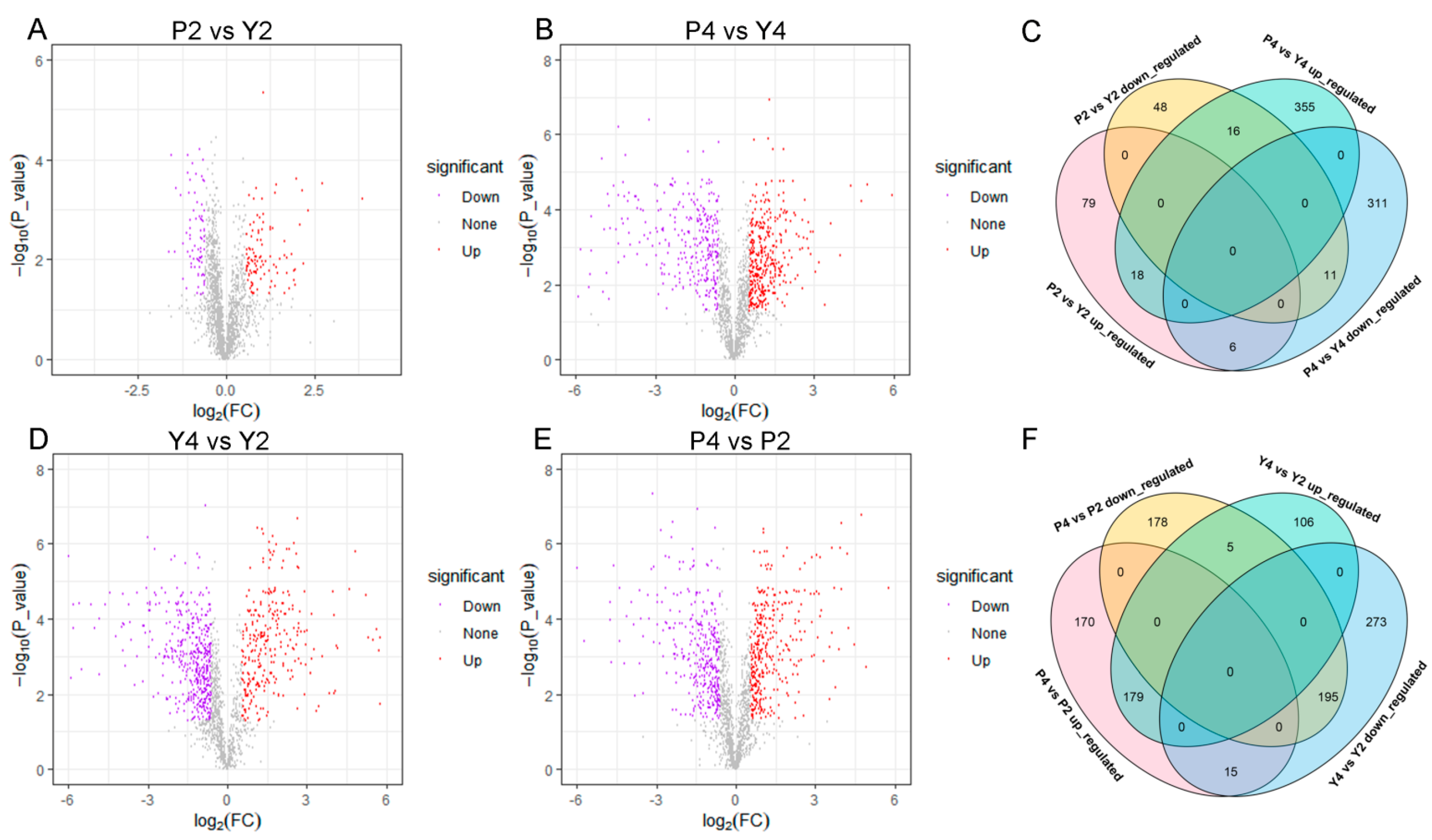
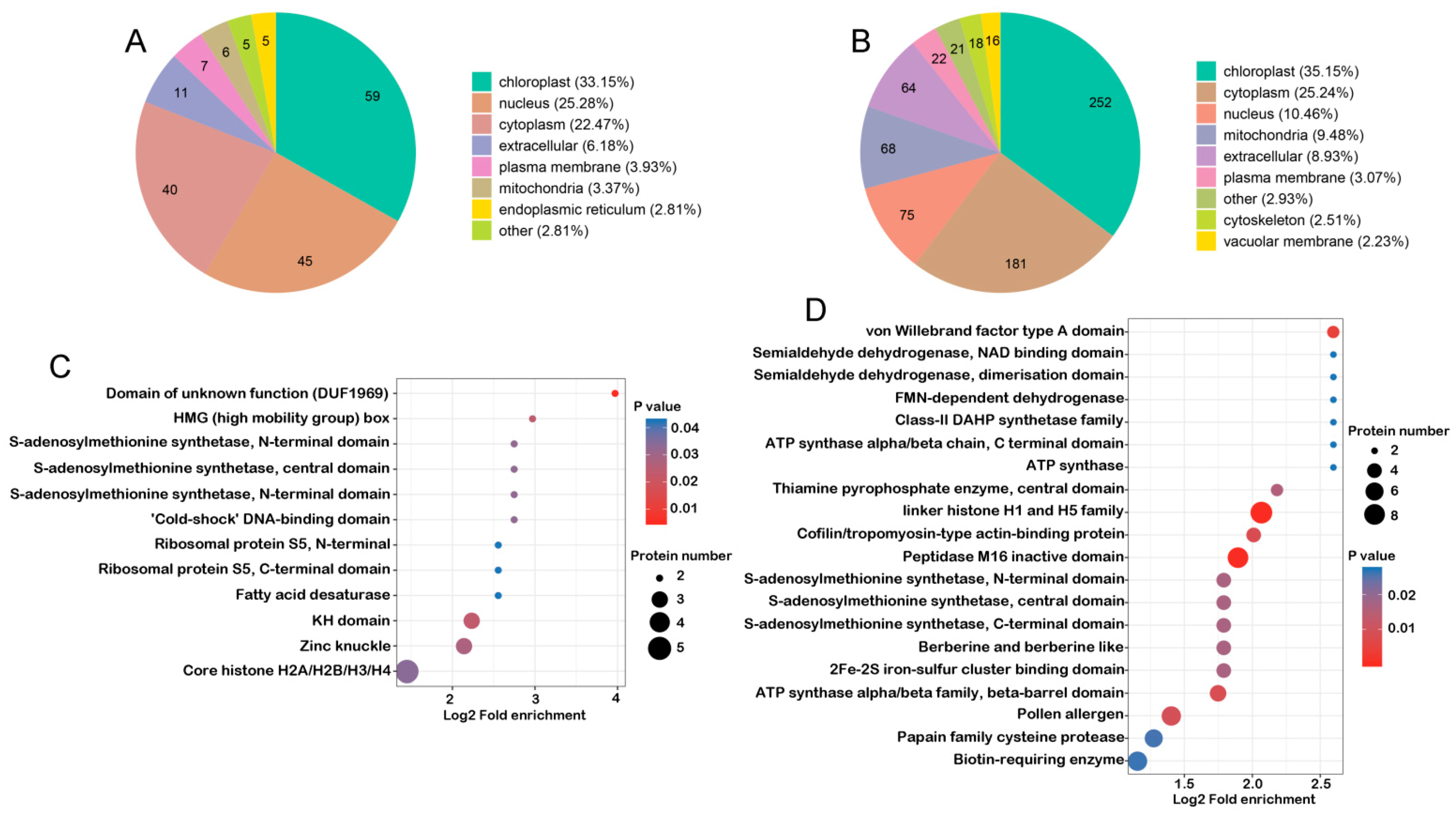
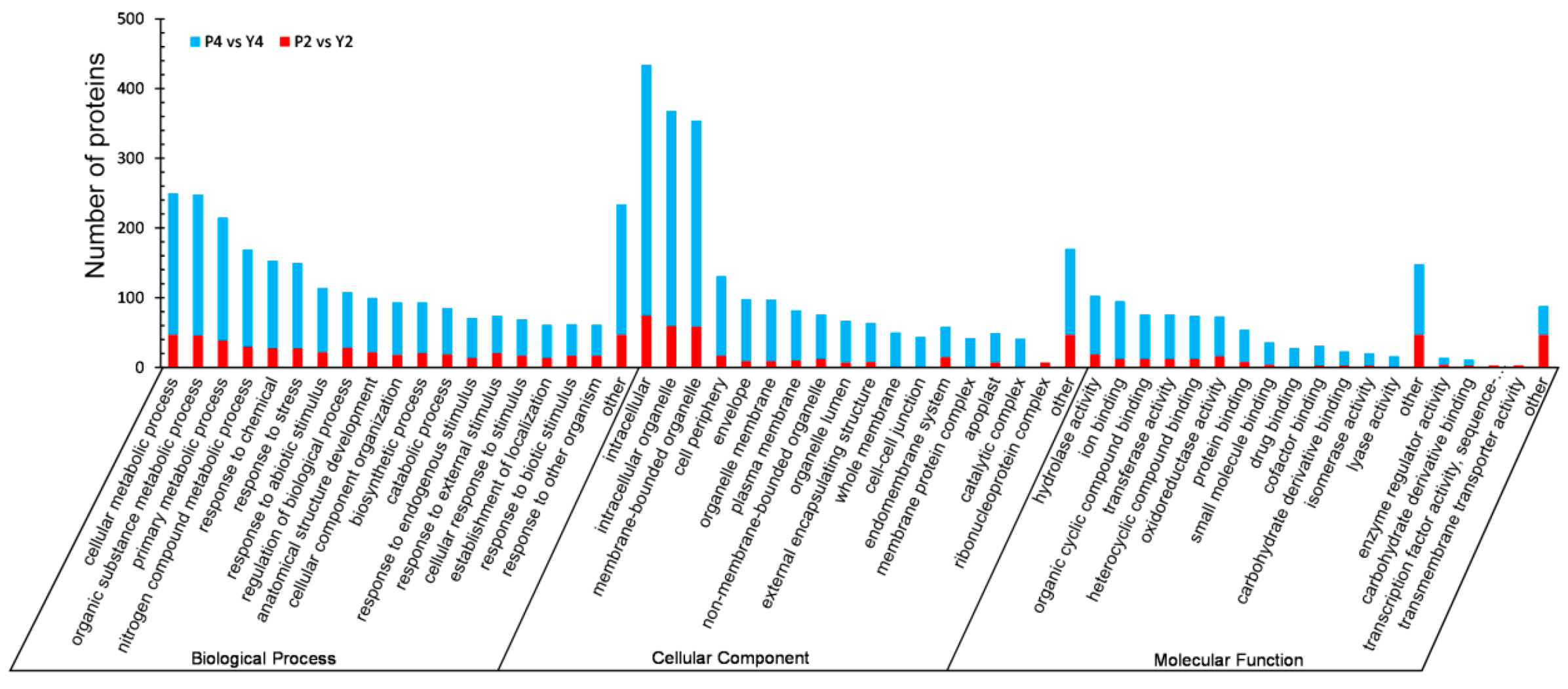



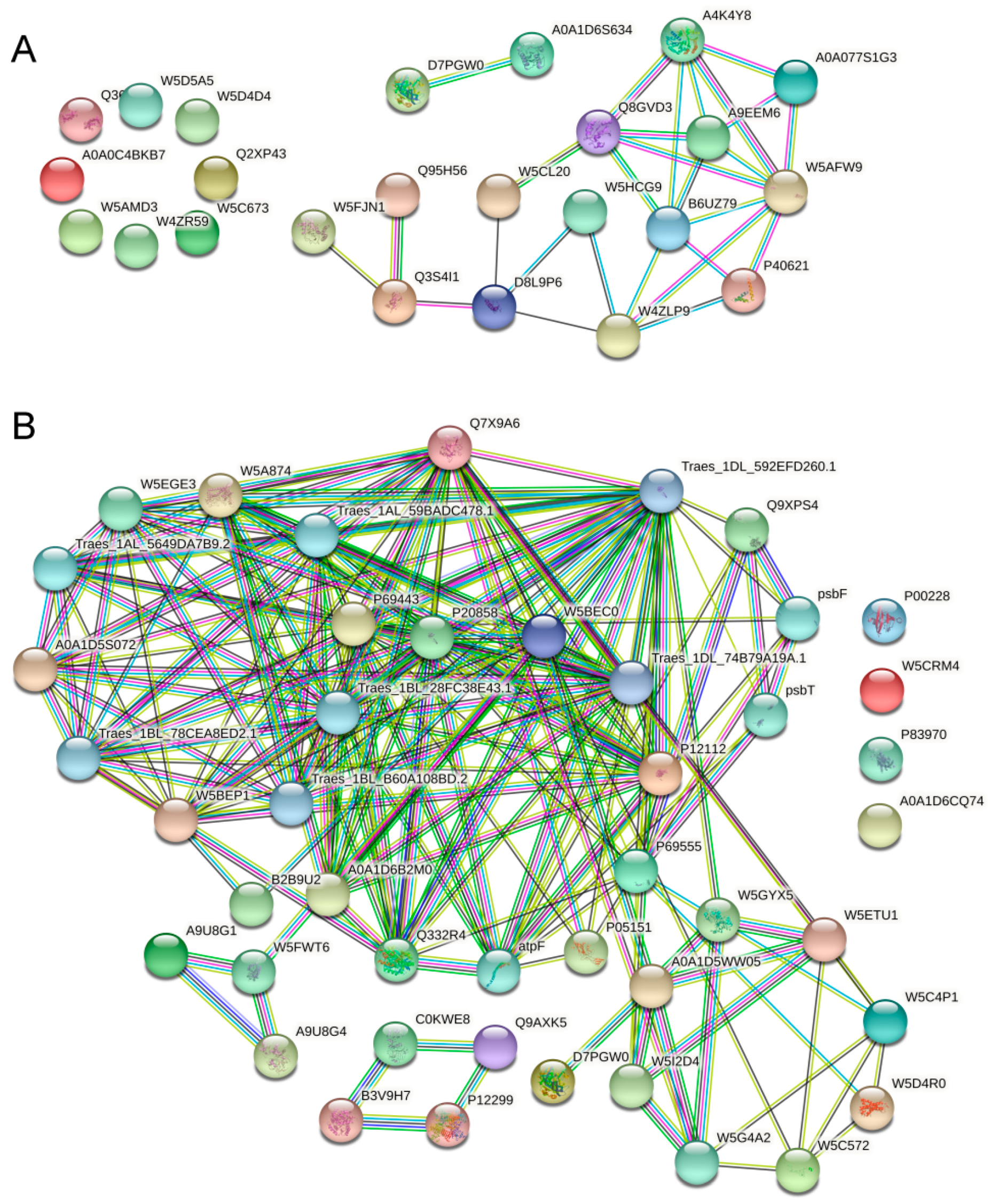
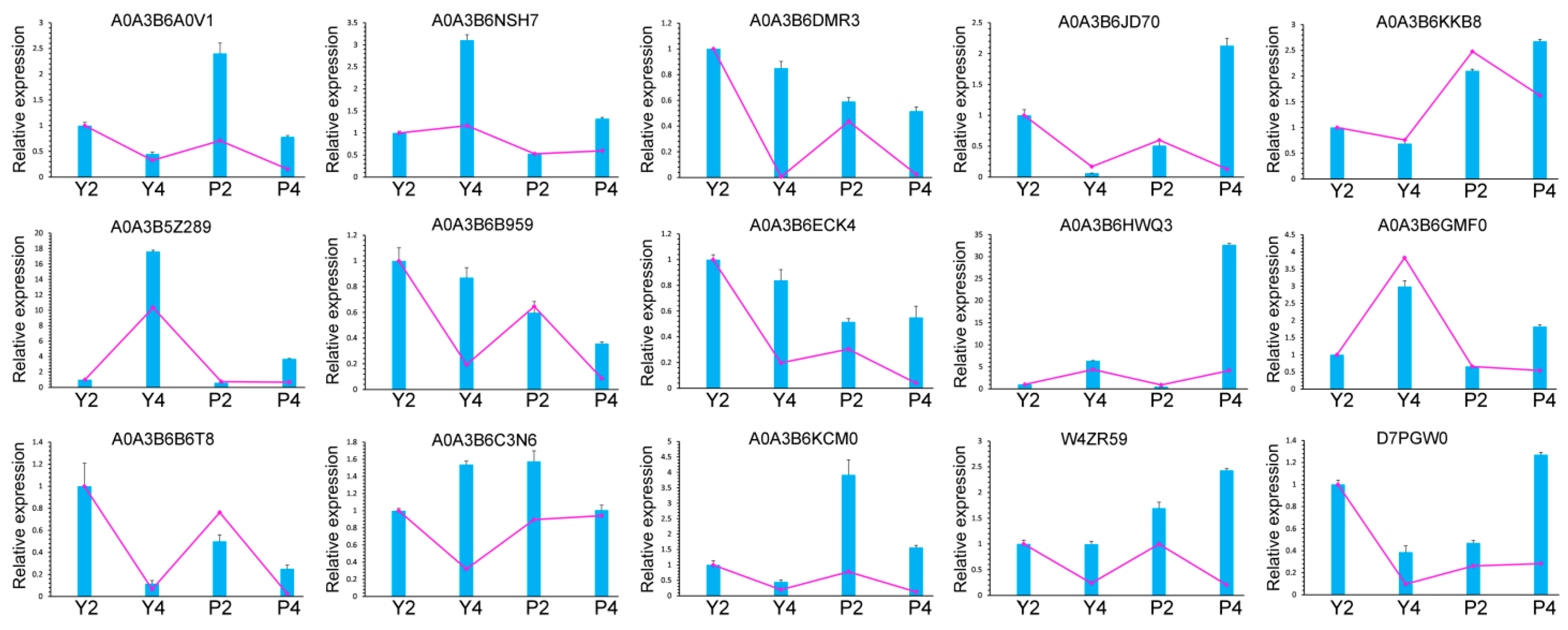

Publisher’s Note: MDPI stays neutral with regard to jurisdictional claims in published maps and institutional affiliations. |
© 2021 by the authors. Licensee MDPI, Basel, Switzerland. This article is an open access article distributed under the terms and conditions of the Creative Commons Attribution (CC BY) license (http://creativecommons.org/licenses/by/4.0/).
Share and Cite
Zhang, Y.; Song, Q.; Zhang, L.; Li, Z.; Wang, C.; Zhang, G. Comparative Proteomic Analysis of Developmental Changes in P-Type Cytoplasmic Male Sterile and Maintainer Anthers in Wheat. Int. J. Mol. Sci. 2021, 22, 2012. https://doi.org/10.3390/ijms22042012
Zhang Y, Song Q, Zhang L, Li Z, Wang C, Zhang G. Comparative Proteomic Analysis of Developmental Changes in P-Type Cytoplasmic Male Sterile and Maintainer Anthers in Wheat. International Journal of Molecular Sciences. 2021; 22(4):2012. https://doi.org/10.3390/ijms22042012
Chicago/Turabian StyleZhang, Yamin, Qilu Song, Lili Zhang, Zheng Li, Chengshe Wang, and Gaisheng Zhang. 2021. "Comparative Proteomic Analysis of Developmental Changes in P-Type Cytoplasmic Male Sterile and Maintainer Anthers in Wheat" International Journal of Molecular Sciences 22, no. 4: 2012. https://doi.org/10.3390/ijms22042012
APA StyleZhang, Y., Song, Q., Zhang, L., Li, Z., Wang, C., & Zhang, G. (2021). Comparative Proteomic Analysis of Developmental Changes in P-Type Cytoplasmic Male Sterile and Maintainer Anthers in Wheat. International Journal of Molecular Sciences, 22(4), 2012. https://doi.org/10.3390/ijms22042012





